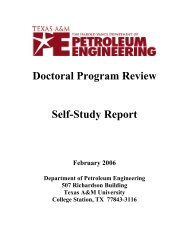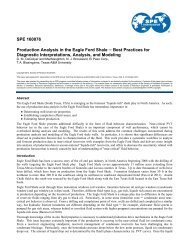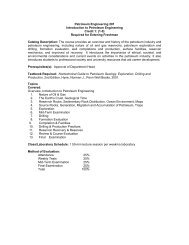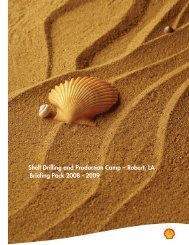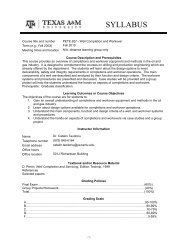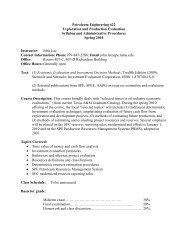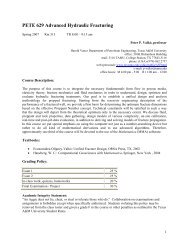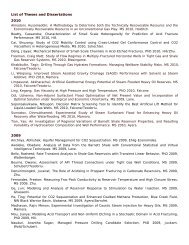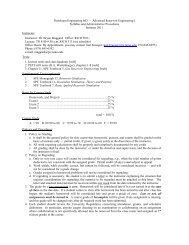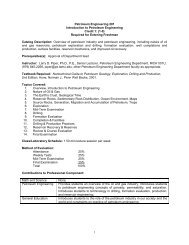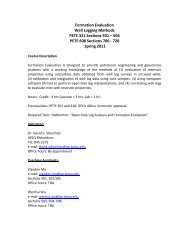Crisman Annual Report 2009 - Harold Vance Department of ...
Crisman Annual Report 2009 - Harold Vance Department of ...
Crisman Annual Report 2009 - Harold Vance Department of ...
You also want an ePaper? Increase the reach of your titles
YUMPU automatically turns print PDFs into web optimized ePapers that Google loves.
Gas Shales Simulation and Production Data Analysis<br />
Objectives<br />
Rate decline forecasting <strong>of</strong> wells in tight gas/shale<br />
gas reservoirs using modern decline curve analysis<br />
can result in dramatic overestimation <strong>of</strong> reserves.<br />
The cause for this error is usually incorrect<br />
interpretation <strong>of</strong> transient flow data (i.e., data which<br />
are NOT affected by reservoir boundaries).<br />
The extremely low permeability <strong>of</strong> shale gas and<br />
tight gas reservoirs causes the transient flow period<br />
to last years or decades. Additionally, the physics<br />
<strong>of</strong> transport and storage controlling the gas flow in<br />
shale gas systems is complex and varies markedly<br />
between reservoirs. Finally, posing yet another<br />
complication, most wells in these reservoir types<br />
are drilled horizontally and hydraulically fractured<br />
multiple times.<br />
the flow concept <strong>of</strong> van Kruijsdijk and Dullaert, and<br />
showed how production data analysis can be used to<br />
identify these flow regimes.<br />
In <strong>2009</strong>, TAMSIM was used to study the effects <strong>of</strong><br />
variation <strong>of</strong> numerous reservoir and completion<br />
parameters on well performance. One paper<br />
(SPE 124961: A Numerical Study <strong>of</strong> Tight Gas<br />
and Shale Gas Reservoir Systems) published this<br />
year served to characterize the effects <strong>of</strong> sorption,<br />
fracture conductivity, fracture spacing, and matrix<br />
permeability for various assumptions <strong>of</strong> single- and<br />
dual-porosity reservoirs, with and without laterally<br />
conductive layers. This work was presented at the<br />
The objectives <strong>of</strong> this research project have been to<br />
build a numerical simulator for shale gas reservoir<br />
systems and to study the complex flow regimes<br />
found around horizontal wells with multiple hydraulic<br />
fractures and enable identification and interpretation<br />
<strong>of</strong> these regimes through production data analysis.<br />
Approach<br />
Our approach has been to determine the proper<br />
theoretical foundation for creating a tight gas/shale<br />
gas simulator, and to implement these concepts<br />
into the purpose-built numerical simulator TAMSIM,<br />
which is descended from the TOUGH+ family <strong>of</strong><br />
numerical simulators.<br />
To determine a sound theoretical basis, we<br />
undertook a literature search, focusing on the<br />
physics and simulation <strong>of</strong> coalbed methane, tight<br />
gas, and shale gas reservoirs. This literature review<br />
also entailed research into specific storage and<br />
transport mechanisms such as flow in naturally and<br />
hydraulically fractured porous media, diffusion in<br />
porous media, and surface sorption.<br />
In 2008, work was focused on implementation and<br />
validation <strong>of</strong> the capability to accurately simulate<br />
horizontal wells with multiple transverse hydraulic<br />
fractures. This part <strong>of</strong> the functionality has been<br />
validated against various other methods, and used<br />
to provide synthetic cases for study and history<br />
matching. Through simulation, we created clear<br />
visualizations <strong>of</strong> the progression <strong>of</strong> flow according to<br />
The progression <strong>of</strong> flow regimes in multiple fractured horizontal wells<br />
(van Kruysdijk and Dullaert [1989])<br />
Project Information<br />
1.2.5 Shale Gas Reserves Estimation<br />
Contacts<br />
Tom Blasingame<br />
979.845.2292<br />
t-blasingame@tamu.edu<br />
C. Matt Freeman<br />
CRISMAN INSTITUTE<br />
20<br />
<strong>Crisman</strong> <strong>Annual</strong> <strong>Report</strong> <strong>2009</strong>



